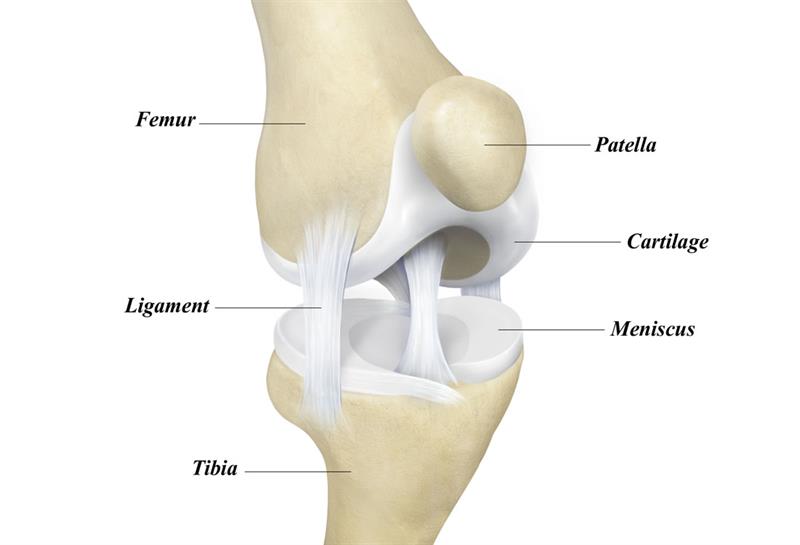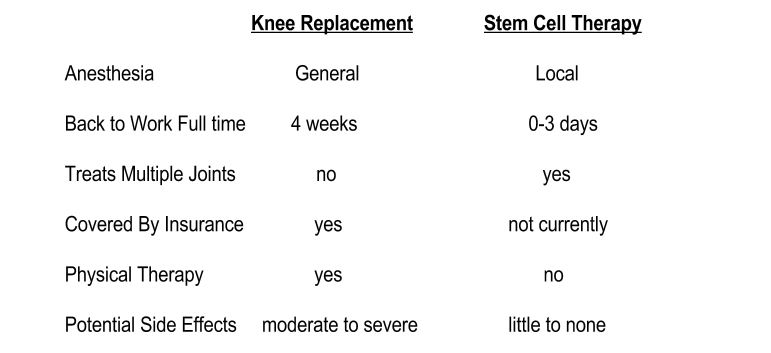Upcoming Webinars
Register NowStem cell treatment or knee replacement surgery? The basics of both.
stem cell or knee surgery

Knees take the brunt of our active lifestyles so it’s no surprise they’re among the most popular body parts for stem cell treatment. In fact, one of the most common questions patients ask is what’s the difference between stem cell treatment for bad knees and knee replacement surgery? We wrote this easy overview to help you understand the basics of both.
What are the procedures?
Your body creates stem cells to replace dying cells or heal damaged tissue. Our physicians collect stem cells stored in the adipose tissue – or fatty deposits – around your waist. We separate the adipose (fat) cells from the regenerative cells and inject them cells directly into your knee. This helps your body speed the healing process, alleviate pain and even allows for the regeneration of new tissue. It’s a one-time near painless procedure that takes about four hours.
During a knee replacement surgery an orthopedic surgeon uses metal and plastic to resurface the parts of the knee damaged by arthritis.[1]
How much do they cost?
Many patients don’t realize that during one stem cell procedure multiple joints can be treated. For the average stem cell treatment cost of $8,900, you can have stem cell therapy for both of your knees, as well as a few other parts of your body such as your hips or wrists. At this time, most insurance providers don’t cover stem cell therapy.
The average cost of a knee replacement surgery is about $35,000 before insurance. But the actual amount you pay differs greatly based on your insurance plan, where you live and the hospital that does the surgery2. Keep in mind that the average cost only accounts for the actual surgery – not follow-up visits or physical therapy. It also only covers the cost of treating your knee – not any other joints.
How long do they take?
Stem cell therapy is a single outpatient procedure that takes about four hours. A small amount of local anesthesia numbs the area. Knee replacement is major surgery that puts patients “under” or asleep with general anesthesia. The actual surgery lasts about two hours. Most patients have at least an overnight hospital stay, months of recovery time, along with follow-up appointments and physical therapy.
What’s the recovery process?
Your body’s response time dictates the stem cell therapy results. But there’s little down time needed after the procedure. There’s a small incision that patients treat with Neosporin and a bandage for one or two days. There are no wounds to dress or stitches to remove. Most patients return to work and resume normal activities the next day.
There’s no official follow-up appointment but our physicians remain in contact with patients after the procedure in order to track their progress.
In the days after a knee replacement surgery, patients stand, begin basic movements and walk with assistance. They’ll have an incision with stitches or staples and will keep the wound bandaged and protected. They may ice their knee, take pain relievers, and use a cane to prevent falls. In the following weeks, they’ll have a post-op doctor’s visit and multiple physical therapy sessions. Patients can’t drive until they’re cleared by their doctor and full recovery from the surgery can take months.1
What’s the success rate of the procedures?
Our research shows that 80 percent to 85 percent of our patients say they’re satisfied with the outcome of their stem cell treatment for knees. Patient satisfaction with knee replacement surgery ranges from 75 percent to 92 percent depending on the source.3
What are the risks of each?
With stem cell therapy, sometimes a patient won’t see the level of relief they hope for – despite the cells doing what they’re supposed to do.
The risks stemming from knee replacement are like those from other major surgeries: pain and stiffness, infection, going “under” with general anesthesia, foreign objects or tools entering your body, as well as using metal or other materials to alter your body parts. In addition, there’s the risk of the replacement wearing out over time.
Healthy knees are a must for an on-the-go lifestyle. Contact us if you’d like to learn more about the basics of stem cell therapy and how it may be an option for treating your knee pain – and other inflammatory and degenerative conditions.
Are You a Candidate?
Our research-based treatments use your own stem cells to accelerate your healing — without surgery.
Request an Introductory Patient Package
Receive an introductory patient package by email.






